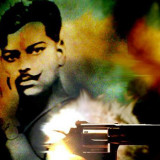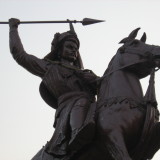“Ramdas is not complete without Shivaji. To maintain justice and prevent the strong from despoiling, and the weak from being oppressed, is the function for which the Kshatriya was created”...Sri Aurobindo
The present generation of Hindus owe much to Shivaji.This short article is a tribute to the great King, whose life has had a profound impact on history, and who was an emblem of both courage and virtue. Shivaji was born in 1627 in a turbulent period when the Hindu people were being oppressed and religiously persecuted by foreign invaders in their own homeland. The carnage included massacres of Hindus, the mass rape of Hindu women, Hindu children taken into slavery, the imposition of heavy discriminatory taxes on Hindus (the Jiziya tax) and the destruction of Hindu temples. Indeed, it seemed like Hinduism was in danger of dying out.
However, his mother, Jijabai raised Shivaji with high ideals of spirituality, heroism and chivalry by inspiring him with the great Hindu epics and heroes of the past ages. With his desire to rise to the defence of the Hindu civilisation and freedom now evoked, he was ready to live up to the seal he prepared for himself at the age of 12 inscribed with the words:
“Although the first moon is small, men see that it shall gradually grow. This seal befits Shivaji, the son of Shahaji.”
From the age of 16, Shivaji began to undertake battles to liberate lands that were under enemy control. His mind was made up by this early age – he wasn’t going to wait around or pray for a champion to be born to renew the rule of dharma.
In one of his early victories he and a small group of friends captured a fort and renamed it Rajgad. With this and subsequent victories Shivaji became powerful and his army grew to thousands, giving him enough confidence to attack and liberate Mughal occupied territories (the Mughals were the most powerful dynasty in India and had most of North India under its control at that time). Shivaji fought with determination and strategic brilliance. He used guerrilla warfare to devastating effect, and made great advances against the much larger and heavily armed Mughal forces. At times Shivaji would enter into a strategic truce, giving him the opportunity to strengthen his positions in other areas, while planning his next offensive.
Shivaji understood that it is better to use cunning strategies and break a truce against an enemy that molested Hindu women and children and destroyed Hindu temples, than to abide by an honourable code of conduct towards the dishonourable enemy and risk losing the urgent cause he stood for. But while Shivaji was brutal against those who oppressed Hindus, he did not permit attacks against their women and children or places of worship. Shivaji stood for dharma; he used might as a tool to establish justice not oppression.
Shivaji died on 4 April 1680, from failing health, thought to be due to his vigorous and continuous struggle. His contribution to our history cannot be overstated. The poet Bhushan, who lived at the same time as Shivaji wrote:
“Kasihki Kala Gayee, Mathura Masid Bhaee; Gar Shivaji Na Hoto, To Sunati Hot Sabaki!” [Kashi has lost its splendour, Mathura has become a mosque; If Shivaji had not been, All would have been circumcised (converted)].
After the untimely death, Aurangzeb the Mughal Emperor and his armies descended upon the kingdom to crush it, thinking that after Shivaji’s death his warriors would be disheartened. However, Shivaji had inspired his followers to such an extent that not only did they weather this storm and saw Aurangzeb’s death but went from strength to strength with Peshwa Baji Rao the First at the realm, and went on to unleash the final death blow to the Mughal Empire.
Shivaji’s legacy can be seen alive to this day. For example, the profound benefits of Hindu spirituality, philosophy, Yoga, meditation, Ayurveda and art resonate not only in India but all over the world. But these practices and knowledge would only be found as partial relics in the museums and libraries like all other ancient civilisations had it not been for great Hindu warriors like Shivaji who protected the great legacy of Sanatan Dharma when it seemed all hope was lost.
“ Shivaji was the greatest Hindu king that India had produced within the last thousand years; one who was the very incarnation of lord Siva, about whom prophecies were given out long before he was born; and his advent was eagerly expected by all the great souls and saints of Maharashtra as the deliverer of the Hindus from the hands of the Mlecchas, and as one who succeeded in the reestablishment of Dharma which had been trampled under foot by the depredations of the devastating hordes of the Moghals”… Swami Vivekananda,
Also read
The Epic 27 Year War That Saved Hinduism
(6356)

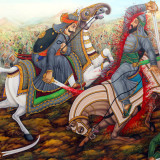
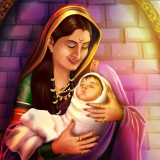













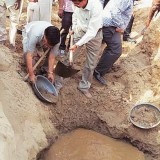

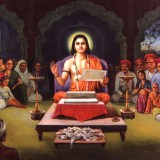
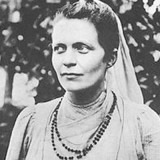
 In 1905-06 she was actively associated with all manner of Indian public affairs; but the strain of her efforts in the relief work in the flood and famine-stricken areas of East Bengal in 1906 broke her health. In August 1907 she left for Europe and America, and returned to India in July 1909.
In 1905-06 she was actively associated with all manner of Indian public affairs; but the strain of her efforts in the relief work in the flood and famine-stricken areas of East Bengal in 1906 broke her health. In August 1907 she left for Europe and America, and returned to India in July 1909.  She encouraged and whole-heartedly supported the Swadeshi (self-reliance) Movement both in principle and in practice. She helped nationalist groups like the `Dawn Society’ and the `Anusilan Samity’; was a member of the Central Council of Action formed by Sri Aurobindo Ghose and took up the editorship of the Karmayogin publication when he left British India.
She encouraged and whole-heartedly supported the Swadeshi (self-reliance) Movement both in principle and in practice. She helped nationalist groups like the `Dawn Society’ and the `Anusilan Samity’; was a member of the Central Council of Action formed by Sri Aurobindo Ghose and took up the editorship of the Karmayogin publication when he left British India.









